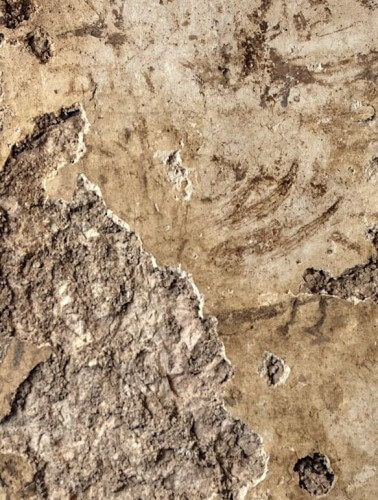The unique find was discovered during the supervision of the Antiquities Authority on the construction of a kindergarten in the Arnona neighborhood, at the initiative of the Jerusalem Municipality

An extraordinary find that ignites the imagination of archaeologists was discovered about two months ago in the Arnona neighborhood during a routine archaeological inspection by the Antiquities Authority on construction work for the establishment of a kindergarten, initiated by the Jerusalem Municipality.
The excavation revealed an impressive mikveh tahara from the times of the Second Temple (1st century AD) inside an underground cave. A porch led to the mikveh, surrounded by benches. Next to the mikveh of purification, a wine cellar was excavated. The walls of the mikvah are covered with ancient plaster, on which there are a lot of inscriptions on the wall paintings that were written with the help of mud, soot and engravings. The language of the inscriptions is Aramaic, and they are written in an eloquent Jewish script, which was customary at the end of the Second Temple period. Among the painted symbols - a boat, palm trees and types of plants, and possibly also a lamp.
According to Roi Grinold and Alex Wigman, the managers of the excavation on behalf of the Antiquities Authority: "There is no doubt that this is a significant discovery. Such a concentration of inscriptions and symbols from the Second Temple period in one archaeological site, and at such a level of preservation, is rare and unique, and extremely intriguing." At this stage of the research, the inscriptions are a puzzle. Some of the inscriptions may indicate names. The symbols depicted on the walls are common in the visual art of the Second Temple period. Meanwhile, the painting that can, perhaps, be interpreted as a menorah is unusual, since in these days the description of this sacred object, which resides in the Temple, was underestimated. According to the researchers, "the symbols can be interpreted on the one hand as symbols with a secular content, and on the other hand as symbols with a deep religious and spiritual meaning."
Moshe (Kinley) Tor Paz, head of the education administration in the Jerusalem Municipality, said: "The great education system in Jerusalem always needs additional construction of educational buildings. The unique find was discovered in the complex where two kindergartens are planned to be built and is now undergoing the preservation procedure of the Antiquities Authority. The archaeological and historical site that was revealed is of great value to our identity as a Jewish people which may shed additional light on the lives of our ancestors in the city of Jerusalem. We will continue to be in contact with the Antiquities Authority and together we will examine how we can give an educational and symbolic expression to the discovery found."
A number of questions are facing the researchers: what is the connection between the symbols and the inscriptions, and why were they painted in the mikvah of taharah? Who is behind their painting - one person or several people? Is someone greedy to scribble the paintings, or is there a desire to convey a deep spiritual and religious message, and perhaps even a call for help as a result of a traumatic event (the destruction of the temple and the war of destruction of 66-70 CE)?
The findings of the paintings are so sensitive that exposing them to the air causes them damage. Upon finding the inscriptions, the Antiquities Authority began a complex conservation activity: they underwent initial treatment on site, were removed in their entirety from the site, and transferred to the Antiquities Authority's conservation laboratories for further treatment and stabilization. In the future, the Antiquities Authority will present the inscriptions to the general public.

3 תגובות
There is no such thing as mikveh tahara. There is mikveh toma.
It looks like someone wiped with their hand and smeared on the wall
It must be written there
It is forbidden to enter the mikvah before taking a shower